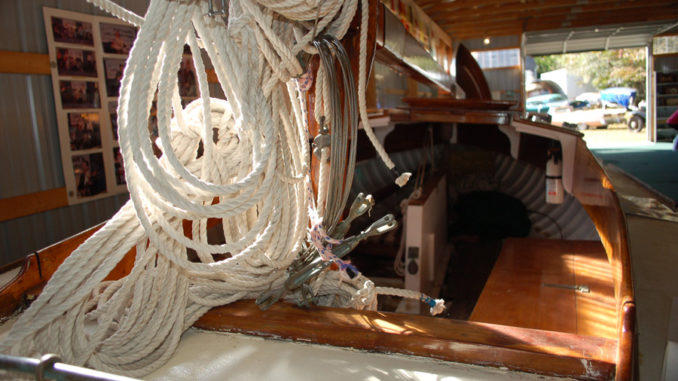
This is the time of year to spruce up the boat for the season. Even the best chrome needs going over after a few months around salt water. The dull haze that accumulates, is made up of oxides of the base metal, that leak out of tiny microscopic holes in the plated surface. This electrolisis is a natural phenomena that plays a part in the breakdown of all dissimilar metals. To restore the original shine, the dull film must be removed with as little scratching of the surface as possible. There are many different liquid chrome polishes, available today, almost all provide about the same things; a mild acid, to melt the oxide and a mild abrasive to help rub it away. Directions generally say, apply, rub, polish with a clean cloth. Problems crop up right away. The worst dull areas are next to the vulnerable varnish.
The acid and the abrasive both, will dull the area around the hardware, so take off parts that are easily removed. Use a table with a light and some newspaper; put on rubber gloves and instead of using a dry rag that sops up the cleaner, use an old damp sponge. Shake the can well, remove the cap and cover the hole with the sponge, tilt the can and apply polish to all the areas to be cleaned. It is preferable to disolve the oxidation so keep re-wetting until everything wipes clean easily. You could rub the chrome with 4 ought steel wool, but this can permanently scratch the chrome and make it easier for it to deteriorate next year. Rub and re-dampen all the surfaces until the part feels slippery, then take an old towel, dry and wipe it clean. Look for dull areas near the edges or spots that need more work.
Go over these again, if need be, choose a fresh spot on the sponge. The oxide removed, and tiny pieces of chrome, get on the sponge and make the cleaner more abrasive, so changing spots saves the shine. When the part looks uniformly bright, get out a scrap of t-shirt and your best auto polish and wax the part. Wipe off where it was and put it back on the boat. Big improvement!
All the tarnished parts can be removed at once and a production line set up, on the bench. Lay out a sheet of plastic, apply polish to all the parts; the first are dry when the last are done, spray lightly with water in an old spray bottle to keep the disolving action going. Rust and heavy brass oxide can be quickly removed by gentle scraping, with a dull pen knife or scraper.
Chrome steering collumns are often rusted on the surface, prep these by gently scraping all the badly rusted areas first. By experimenting with knives of just the right dullness you can remove the oxide without scratching the surface. Chrome is very hard. This scraping technique can also be used to pre-clean cracks and detail areas. It can be difficult to polish down into valleys and convolutions, on some parts. Tooth brushes come in handy, both for polishing and for removing the white accumulated polish. All the cracks have to be cleaned and done with wax. It would be great if there was another protectant for bright parts. Imron and acrylic finishes are successful on brass but chrome is slippery and easily looks yellow, so wax is still best.
Polishes and waxes all differ in contents and performance. most white liquid chrome polishes are similar. Never Dull and Brasso require more effort. Some auto waxes are better than others and the finish coating or sealer types last longest.
When parts can’t be removed masking with coffee can plastic lids works.
Polyethelene plastic can be cut to fit around the part or slipped under it.
Work on a towel or carpet. Put a baking pan under the can. Murphy’s Law says, The polish wants to spill on the deck and run into a crack that was not noticible before! Clean up white residue with a tooth brush and water in a spray bottle, dry with old toweling while wet. Fresh looking chrome really makes the boat look sharp. See you at the show!

Be the first to comment